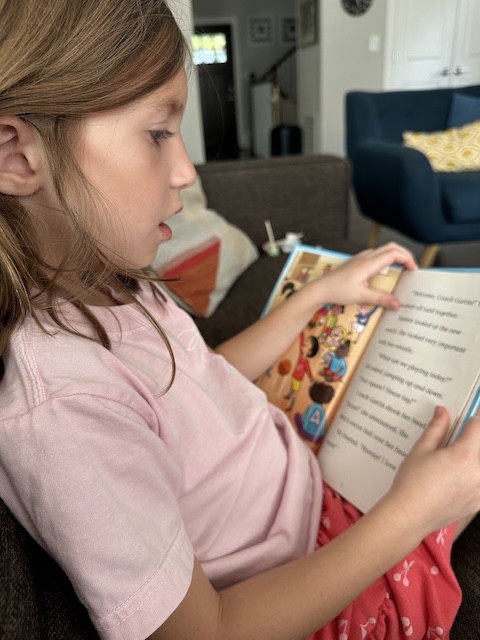Teacher question:
My question is regarding comprehension as it relates to solving math word problems. I have observed almost all word problems begin with presenting the data first (We ate five apples…) then asking the question (How many apples…?) I have noticed when I ask the question first, it seems to narrow their working memory on the relevant detail (s) and I am noting marked improvement in 1) understanding what it is they need to do, 2) extracting the relevant details and 3) employing the correct operations. Your thoughts on the order in which questions are posed. Part 2) Are there studies showing how increasing reading ability (Science of reading) impacts math abilities especially in primary students? It seems logical that since testing is generally reading based across subject areas, scores would improve but has this been measured?
Shanahan response:
The relationship between reading and math has long been of interest to scholars. For a long time, the data were pretty confusing.
They found reading ability to be an important precursor to better math performance (hooray, hooray). But they also reported the reverse – better math skills presaged reading improvements. That, of course, makes little sense.
While reading arguably would enable students to do story problems or to read the directions on a math test, why would being nimble with long division increase one’s ability to decode words or comprehend stories?
Research on those issues has gotten more astute – and better and more extensive data sets have been brought to bear on the issue (Bailey, et al., 2020).
One reason math and reading may have looked so interdependent in older studies could be the result of the influence of common underlying abilities or enabling conditions. Being smart, industrious, careful, motivated, and having a good memory could play a role in learning anything, including both math and reading. Likewise, supportive parents, good nutrition, sufficient sleep, and the availability of high-quality teaching might benefit reading and math.
A recent example of this kind of analysis was a study that found that first-grader’s executive functioning was implicated in later improvements in both reading achievement and mathematics (ten Braak, Lenes, Purpura, Schmitt, & Størksen, 2022).
As data sets have improved, more complex and well controlled studies have provided deeper insights into the direct relations between reading and math. These newer studies have offered some valuable insights. For instance,
- Reading and math do co-develop during the elementary school years, but reading ability was found to promote higher math achievement – not the reverse. This study of 355,883 students tracked development in children across the ages 5-12 (Hübner, Merrell, Cramman, Little, Bolden, & Nagengast, 2022). The researchers concluded that “acquiring good reading skills is highly relevant for developing mathematics skills.”
- A study of 46,373 students (ages 5-19) also found that reading comprehension had a significant impact on math learning across the grades (Grimm, 2008). Reading achievement had an impact on conceptual understanding of math and the application of math knowledge (both the kinds of skills involved in story problems), but not on computation. Controlling for differences in earlier math skills, reading performance enabled more rapid improvement in later math learning.
- In a third study, reading comprehension mattered in the mathematics performance of fourth-grade students, but only for the low and average performing students (Chang & Ko, 2012). Reading apparently played little role in the performance of the highest achieving math students (with them math knowledge and other mathematical abilities are most important). According to the authors, “reading ability appears to be a critical foundation for the lower-mathematics performance group.”
- I mentioned earlier that factors like poverty may have a general impact on all kinds of academic achievement. While that may be generally true, research has found poverty to exercise a greater impact on reading achievement than on math (Eamon, 2002). This should not be surprising – we learn more language at home – stimulating home language environments are an important factor in literacy learning; math is more often relegated totally to the school, which means home environment won’t matter as much.
- Another important separation between reading and math is their impact on the learning of other subjects. A study of 12,058 students explored the role that these foundational subjects play in science learning (Zhu, 2022). The analysis showed that both math and reading mattered in this regard, but that reading was much more influential, and that reading should be accorded greater attention in science instruction.
These studies (and dozens more cited by each of these) reveal the importance of reading in math development – particularly in the application of math knowledge in problem solving and for the lowest achieving students.
Here’s a particular pregnant example from the Zhu, 2022 study (p. 3):
Many researchers have shown that there is a close correspondence between student performance in reading and mathematics (Adelson et al., 2015; Harlaar et al., 2012; Kyttälä & Björn, 2014). Language-related factors, particularly students’ reading ability, can affect their performance on mathematics assessments (Ajello et al., 2018; Isphording et al., 2016; Trakulphadetkrai et al., 2020; Walker et al., 2008). As a result, reading can be used to predict the outcomes of math tests (Beal et al., 2010; Codding et al., 2015; Foster et al., 2019). Reading comprehension can also account for ‘a considerable proportion of the variance in mathematics performance (Ding & Homer, 2020). Some researchers even found that children with dyslexia were ‘5.60 times and 8.54 times more likely than other children to experience deficits in fact fluency and operations, respectively’ (Vukovic et al., 2010). Furthermore, some recent studies analysed this topic in detail. They reported that it was syntax and early written language skills predicted mathematics performance, rather than vocabulary or phonological awareness (Birgisdottir et al., 2020; Chow & Ekholm, 2019). In a word, prior reading skills are important for students to learn mathematics (Erbeli et al., 2021; Grimm, 2008).
So, indeed, reading contributes to math development (even in the primary grades)—and, at least in part, this contribution is channeled through story problems. As with studies of the relationship of math and reading development, there have been valuable recent advances in this area of research, too.
In fact, Lynn Fuchs and her colleagues (2010, 2014, 2018, 2021, 2022) have published several studies in the past year or so that go right to the heart of your question. Though there is long history of research on story problems, I think this newer work is admirable both in its clarity and rigor, but also in its careful consideration of knowledge drawn from past research – and it focuses on young readers particularly.
Without going into too much detail these studies have found that it is beneficial to teach students to recognize the structure of story problems (are they asking for the combination, comparison, or changes of quantities), and then to translate that structure into a diagram or equation that maps onto the “story.”
The studies have found it efficacious to teach those structures and to include relevant reading comprehension instruction that helps students to make sense of the language of the problems. For instance, they are taught the vocabulary alternatives they might confront in story problems of different types (in all or altogether in combination problems, or more, fewer, than, and -er words for comparison problems).
These scientists were quick to point out that they did more than teaching students to recognize these key words but guided them to interpret those words embedded in the story problem language. The students were not just searching for comparison words but were guided to read the entire problem to identify the problem type and they spent a lot of time re-analyzing the language to see why they may have ended up with the wrong operations or the wrong numbers. In other words, as mentioned earlier the language challenge in math is more rooted in making sense of the sentence syntax than in isolated vocabulary.
Fuchs and company provide from past research a helpful example of the importance of language and structure in the interpretation of story problems (Hudson, 1983). These two story problems were posed to young children. The second version resulted in a whopping 83% performance improvement, which reveals the difficulty to be more with the language than the computation.
There are 5 birds and 3 worms. How many more birds were there than worms?
There are 5 birds and 3 worms. How many birds won’t get a worm?
The students obviously failed to recognize that these problems required the same mathematical operations. Teaching them to recognize the equivalence of the language in these versions and giving them tools for translating that language into diagrams or equations made a big learning difference.
So, indeed, early reading development plays an important role in later progress in math. Students need to learn how to understand and operate effectively on math language.
Despite recent popular claims that reading comprehension depends solely on decoding ability and knowledge of the social and natural world, this research illustrates the importance of knowing how to interpret language when it comes to comprehension.
Knowledge is important (you can’t get these story problems right without an understanding of computation), but that is not enough for success. To solve these problems, students must develop a rich relevant vocabulary along with the syntactic skills that allows them to make sense of the relations among the words in the problem and of their connection with students’ math knowledge.
Lynn Fuchs and company are improving students’ ability to “do math” by teaching young students to comprehend a particular type of language. More of that should be occurring in primary grade reading and math classes.
References
Bailey, D.H., Oh, Y., Farkas, G., Morgan, P., & Hillemeier, M.M. (2020). Reciprocal effects of reading and mathematics? Beyond the cross-lagged panel model. Developmental Psychology. doi.org:10.1037/ dev0000902.
Chang, C., & Ko, H. (2012). The relationship between mathematics achievement and reading comprehension: TIMSS 2003 and PIRLS 2006 test items as measuring instruments. Bulletin of Educational Psychology, 44(1), 95-116.
Eamon, M. K. (2002). Effects of poverty on mathematics and reading achievement of young adolescents. Journal of Early Adolescence, 22(1), 49-74. doi.org/10.1177/0272431602022001003
Fuchs, L. S., Fuchs, D., Sterba, S. K., Barnes, M. A., Seethaler, P. M., & Changas, P. (2022). Building word-problem solving and working memory capacity: A randomized controlled trial comparing three intervention approaches. Journal of Educational Psychology. doi.org/10.1037/edu0000752
Fuchs, L. S., Gilbert, J. K., Fuchs, D., Seethaler, P. M., & Martin, B. N. (2018). Text comprehension and oral language as predictors of word-problem solving: Insights into word-problem solving as a form of text comprehension. Scientific Studies of Reading, 22(2), 152-166. doi-org:10.1080/10888438. 2017.1398259
Fuchs, L. S., Powell, S. R., Cirino, P. T., Schumacher, R. F., Marrin, S., Hamlett, C. L., . . . Changas, P. C. (2014). Does calculation or word problem instruction provide a stronger route to pre-algebraic knowledge? Journal of Educational Psychology, 106, 990–1006. doi.org/10.1037/ a0036793
Fuchs, L. S., Seethaler, P. M., Sterba, S. K., Craddock, C., Fuchs, D., Compton, D. L., . . . Changas, P. (2021). Closing the word-problem achievement gap in first grade: Schema-based word-problem intervention with embedded language comprehension instruction. Journal of Educational Psychology, 113(1), 86-103. doi.org:10.1037/edu0000467
Fuchs, L. S., Zumeta, R. O., Schumacher, R. F., Powell, S. R., Seethaler, P. M., Hamlett, C. L., & Fuchs, D. (2010). The effects of schema broadening instruction on second graders’ word-problem performance and their ability to represent word problems with algebraic equations: A randomized control study. The Elementary School Journal, 110, 446–463. doi.org/10.1086/651191
Grimm, K. J. (2008). Longitudinal associations between reading and mathematics achievement. Developmental Neuropsychology, 33(3), 410-426. doi.org/10.1080/ 87565640801982486
Hübner, N., Merrell, C., Cramman, H., Little, J., Bolden, D., & Nagengast, B. (2022). Reading to learn? The co-development of mathematics and reading during primary school. Child Development. doi.org/10.1111/cdev.13817
Zhu, Y. (2022). Reading matters more than mathematics in science learning: An analysis of the relationship between student achievement in reading, mathematics, and science. International Journal of Science Education, 44(1), 1-17. doi.org/10.1080/09500693.2021.2007552







Comments
See what others have to say about this topic.